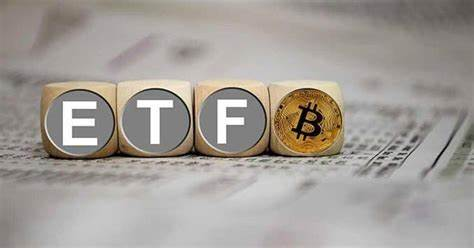Reviewing the eight-year route of Bitcoin ETF in the United States: from unreachable to expected
image description

(Gensler teaches a Blockchain course at MIT)
SEC Chairman Gary Gensler has always advocated the inclusion of Crypto into the regulatory framework, and the only way to incorporate into the framework is naturally to provide investors with compliant Crypto exposure. On September 30, he expressed his support for BTC futures ETF funds instead of BTC spot ETF funds. As of now, a total of 9 BTC futures ETFs are waiting for SEC approval.
Just a few days ago, the SEC just approved the Volt Crypto Industry Revolution and Tech ETF (Volt Crypto Industry Revolution and Technology ETF). From entities that mine, lend or trade BTC. This is also considered by the market to be the prelude to the BTC ETF.
After one after another of regulatory dynamics, the approval of BTC ETF seems to be just at the door. These news have aroused strong attention from the market, and the market sentiment continues to pick up. If the SEC finally approves Crypto ETFs, it will undoubtedly have a demonstration effect in traditional finance. If Crypto ETFs come one after another and financial giants compete to buy Crypto, it is not impossible.
first level title
Why are ETFs important?
In the traditional financial system, ETF is an extremely important part. Because when a commodity can appear in the form of an ETF, it means that the commodity is compliant and mature locally. Exchange-traded funds (ETFs) can securitize specific assets in the form of physical guarantees. Investors only need to purchase the fund shares issued by the institution to indirectly hold exposure to the corresponding investment targets . This product was invented by Vanguard Ventures founder John Berger. In 1993, he launched the world's first and still famous index ETF, the S&P 500 ETF.
A few years after the stock index ETF was born, the first bond ETF was born in 2001. After years of development, the types of ETFs have gradually enriched. How important are ETFs in today's financial markets? Now that we have entered an era where everything can be ETF, Canada even launched the world's first marijuana-themed ETF.
Currently, there are three well-known BTC ETFs in the world: Purpose BTC ETF with 21,700 BTCs, 3iQ CoinShares BTC ETF with 20,200 BTCs, and CI Galaxy BTC ETF with 3,393 BTCs. Crypto is a rapidly emerging new asset, and many institutions are interested in it. However, limited by compliance requirements, if you want to hold this asset, there are not many investment targets to choose from.
In the first half of 2021, BTC once again ushered in a continuous rise. What is different from the past is that this bull market is dominated by institutions, and the amount of funds of investment institutions and listed companies is far beyond that of retail investors. With the help of massive funds, BTC also hit a record high of 64,000 US dollars. Although Crypto has attracted the attention of traditional finance, most of the large traditional financial institutions have not deployed Crypto. Regulatory and compliance issues have always constrained mainstream financial institutions from configuring Crypto exposure. ETF is compliant, regulated, and has good liquidity and can be traded within the day. If there is a Crypto ETF, it will undoubtedly completely open the door to the Crypto world and traditional finance.
image description

(Spot gold that is not easy to deliver is not the first choice for investors to trade gold)
Let's take gold as an example. Statistics show that the current global gold Bars and Coins (gold bars and coins) scale is about 38,000 tons, while the gold ETF market size has reached about 2,200 tons. Accounted for 5.6% of the B&C gold market share. If this ratio is calculated, ETF can attract about 6% of the current total market value of funds into the market, which is about 60 billion US dollars based on the current market value.
first level title
The "Great Route" of BTC ETF
The development of BTC ETF can be described as ill-fated. Back in 2013, the Winklevoss brothers announced the upcoming launch of a BTC ETF. In 2014, the ETF was rejected by the SEC after submitting its application. Since then, the Winklevoss brothers have attempted to set up a BTC ETF in various ways such as changing trading venues and establishment locations. They have applied for several times over the years, but all have failed. The plan is still on hold. This may be the first attempt at a BTC ETF.
In 2016, SolidX's application for a Bit ETF was rejected. 2017 is a year when BTC ETF seems to be developing rapidly. The price of BTC has changed drastically this year, from the lowest at the beginning of the year at $789 to the highest at the end of the year at $18,674. Within a year, several BTC ETF funds applied for establishment. From BTC Investment Trust at the beginning of the year, VanEck in the middle of the year, and Exchange Listed Funds Trust, Pro Shares, REX BTC, and First Trust at the end of the year, six ETFs submitted applications within one year. However, unfortunately, they were either rejected by the SEC or revoked on their own initiative, and none of them were successfully issued.

In 2018, even in the context of the continuous decline in currency prices, new ETF applications have not been suspended. This year, two new players, GraniteShares and Direxion, were added to the market, as well as two old players: VanEck and SolidX jointly applied for an ETF. But no different from the past year, the former two ETF applications were rejected by the SEC, while the latter's application was voluntarily withdrawn due to the breakdown of the partnership.
At that time, the SEC had not yet made a clear characterization of BTC, and Crypto was neither a security nor a financial derivative. As a non-physical commodity, BTC is theoretically not regulated by the US Securities and Exchange Commission and the Commodity Futures Trading Commission (Commodity Futures Trading Commission), which is one of the main reasons why BTC ETFs are frequently rejected.
Since then, one or more BTC funds have submitted applications every year, but without exception, they have all failed. Applications have been repeatedly rejected, expectations have repeatedly failed, and the issuance of BTC ETFs seems to stay in "next year" forever. To this day, the issuance of "the first BTC ETF in the United States" is still in the state of "hopeful to pass".
When the time comes to 2021, the wheel of history finally turns slowly forward. In February of this year, Canada approved the world's first BTC ETF - Purpose BTC ETF. After the ETF (stock code BTCC) was officially listed on the Toronto Stock Exchange in Canada, the total trading volume on the first day was 9.3 million shares, and the total transaction volume reached 145 million US dollars, making it one of the top ten most actively traded securities on the Toronto Stock Exchange that day.
first level title
Represented by Grayscale, an alternative to ETFs
image description

(Traditional financial institutions on Wall Street cannot easily configure Crypto exposure)
If a compliant institutional investor is bullish on Crypto, how can he allocate Crypto exposure in full compliance? Grayscale Trust is one of the answers. In this round of institution-driven bull market, the rapid rise of Grayscale Trust has also allowed the traditional financial industry to see new opportunities - entering the Crypto world is a real demand that the market urgently needs. Even at the moment, Grayscale still has the largest holdings among institutions, and its BTC holdings have reached 649,000. For a long time, grayscale trust shares have been one of the main ways for institutions to indirectly invest in Crypto currencies.
Unfortunately, grayscale trust, it is not so "easy to use". Grayscale is not a true ETF product and has long been considered an alternative to Crypto ETFs. Although it provides institutions with Crypto exposure, Grayscale Trust also has a huge disadvantage compared to real ETFs. Grayscale Trust’s GBTC shares not only have a 6-month lock-up period, but can only be resold after unlocking and cannot be redeemed. This special mechanism may also be one of the reasons for the long-term premium of Grayscale shares compared to BTC. For several years, Grayscale GBTC has maintained a high premium level, even exceeding 100% at the highest. The lack of a regulatory framework means that institutional investors lack easy-to-use tools for entry.
In addition to Grayscale Trust, there are other alternatives in the market. As early as 2017, France Tobam issued the world's first BTC mutual fund. In the same year, Switzerland's Swissquote Group launched a BTC certificate ETP product, which was listed on Six Swiss, the largest stock exchange in Switzerland. Since then, countries such as Germany, Sweden, and Austria have successively issued Crypto ETP products. Similar to the disadvantages of Grayscale Trust, these products can only meet some of the functions of ETFs - ETPs are essentially bonds and cannot be included in the regulatory framework of funds.
Within the current regulatory framework, Crypto ETFs are the real needs of the market. After all, alternatives to ETFs cannot really replace ETFs. If a Crypto ETF can be established, a fully compliant financial product that can be traded within the day and that financial institutions can purchase as a fund can be established. This greatly reduces the threshold for institutions to configure Crypto. This is also one of the reasons why the Crypto industry has been repeatedly rejected for eight years but is still applying.
CryptoETFs are currently on the mend of acceleration. However, in the United States, the most capital-intensive country, there is still no compliant ETF launched. According to statistics, up to now, at least 15 asset management institutions in the United States have applied for Crypto ETF at least 35 times. Unfortunately, none of them have been approved so far. With the gradual improvement of the compliance framework, the door of the Crypto world is gradually opening to traditional finance. If the BTC futures ETF is approved this time, it may have a certain demonstration effect in the traditional financial field. As for whether the US Crypto ETF is keeping up with the pace of other regions, or whether it is "hopefully launched" for several years, we still need to wait for time to give the answer.



